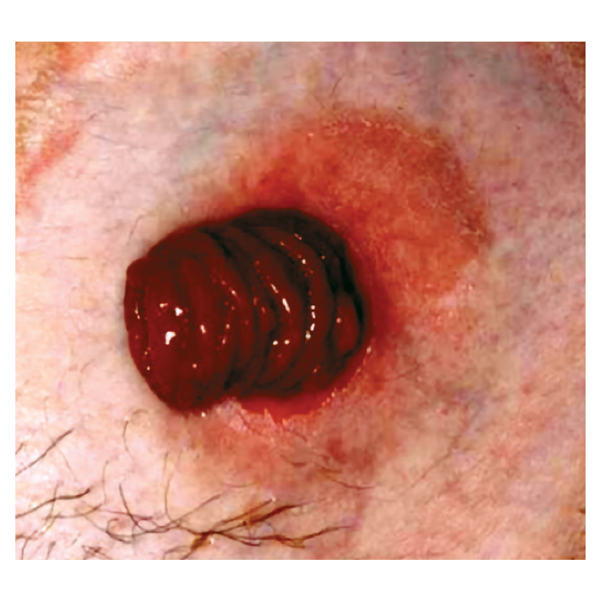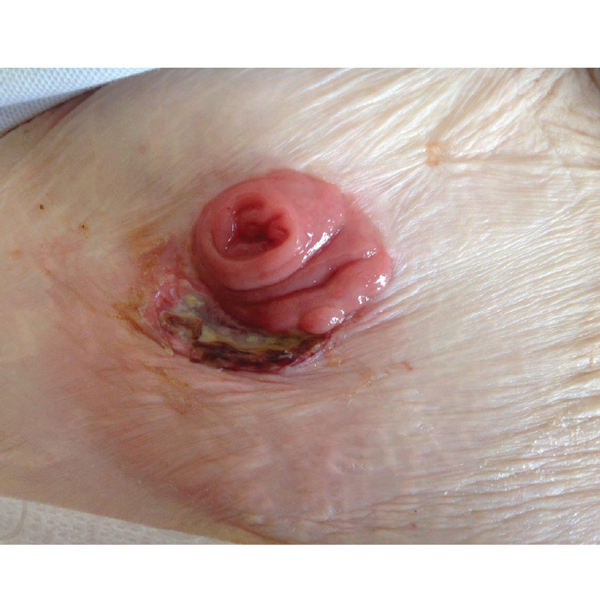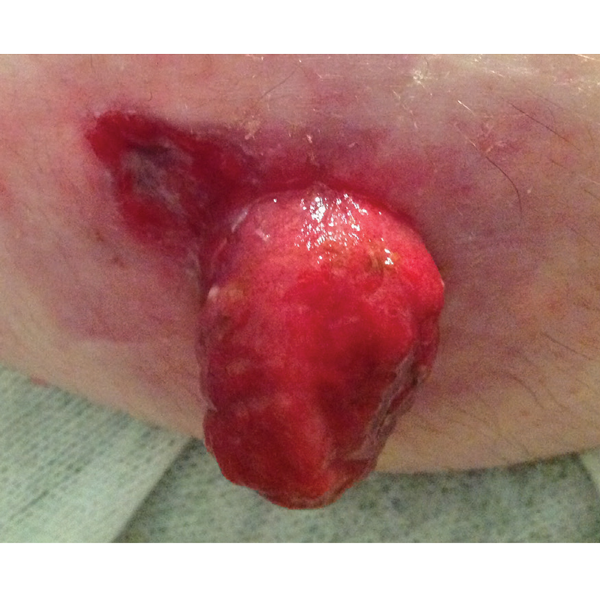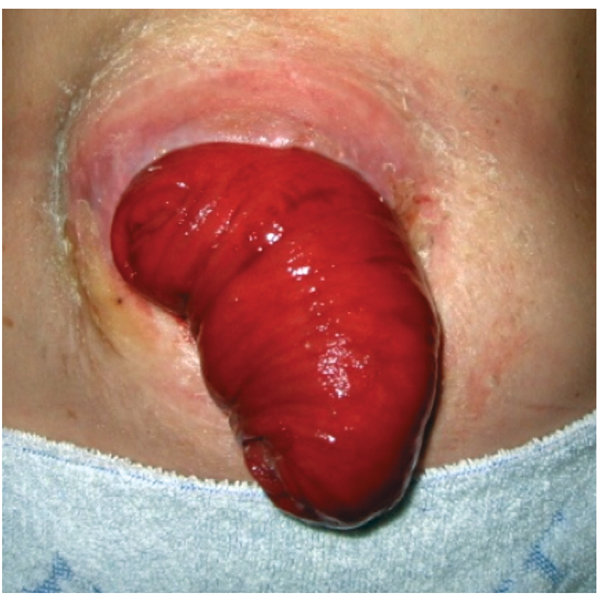Contact Dermatitis

The skin is red or discoloured and has a moist surface which sometimes bleeds. It is usually caused by the exposure of skin to faeces or urine, which may be a result of leakage of the product or incorrect template size.
Solution:
- Assess template size and correct this if necessary.
- Ensure that any moist eroded skin is dry, prior to application of the appliance, by using ostomy powder (if available) or a hairdryer on a cool setting.
- If the skin is red but dry, use a barrier film.
- If the condition of the skin has not improved in a week, refer the person living with a stoma to a Stoma Care Nurse.
Stoma in a crease

The stoma may be situated in a skin crease, which results in persistent leakage of the product.
Solution:
- The person living with a stoma should be referred to a Stoma Care Nurse who will advise on the most appropriate product. This may be the use of a soft convex product and/or possibly some additional paste or a seals.
- Encourage the person living with a stoma to hold up any abdominal skin folds, in order to flatten any minor skin creases whilst applying their stoma pouch.
Granulomas

These small, reddish, raised nodules or lumpy lesions mostly occur at the mucocutaneous junction. They can bleed easily and impair appliance adhesion. Some people living with a stoma can find the presence granulomas extremely painful. Repeated friction from the pouch can make this worse. Granulomas are harmless, but they bleed readily when touched and may cause leakages to occur.
Solution:
- The person living with a stoma should be referred to a Stoma Care Nurse who will advise on appropriate treatment.
Nicorandil Ulcer

This type of ulceration can occur on people living with a stoma who are taking a medication called Nicorandil (a treatment for angina).
Solution:
- As soon as the medication has been identified as the cause for the ulceration, and then subsequently altered by the GP or Cardiologist, the ulceration will heal and clear. Protection of the ulceration by ostomy powder or an alginate dressing with alcohol-free stoma paste or a seal may be required to allow the product to adhere to the skin until it heals.
Parastomal Hernia

A parastomal hernia is a very common complication. It occurs as a result of a weakness of the muscle layer resulting in the protruding of internal organs through the muscle layer and appear as a bulge around the stoma. This can make it difficult to achieve a secure seal around the stoma and may result in leakage.
Solution:
- Check the template to ensure correct fit as the stoma may have changed shape and size. Often the presence of a parastomal hernia will increase the template size quite dramatically.
- Consider using an product specially designed for use with parastomal hernias.
- The Stoma Care Nurse may recommend the use of an abdominal support garment.
Allergy

Allergy presents as a well-defined erythema which is often oedematous and will often mirror the shape of the adhesive. Itching is also a common feature.
Solution:
- Refer the person living with a stoma to a Stoma Care Nurse who may well recommend a patch test or referral to Dermatology. Treatment may include changing the make of the bag (ie change brand/manufacturer) or a course of topical steroids.
Mucocutaneous Separation

Separation of the mucocutaneous junction is caused by a breakdown of the suture line between the bowel mucosa and the skin securing the stoma to the abdominal surface.
Solution:
- This depends on severity. If superficial, use an ostomy powder and a seal underneath the appliance to protect the skin. If separation is deep, an alginate dressing may be required. Contact the Stoma Care Nurse for advice.
Pyoderma Gangrenosum

Pyoderma Gangrenosum (PG) is a rare and serious condition comprising of painful ulceration of the skin. Lesions can progress rapidly, from a pimple to a crater, within 48 hours, and have a purplish tinge. The ulceration can often display a web-like appearance as it progresses.
Solution:
- Urgent referral to a Stoma Care Nurse, Dermatologist or Gastroenterologist.
Prolapse

Prolapses may occur in any type of stoma, but are more common in loop stomas. Sometimes, the muscles holding the stoma weaken and allow the bowel to telescope out, increasing the length of the stoma. Prolapsed stomas are difficult to manage and can often cause the person living with a stoma a great deal of anxiety whilst trying to change their pouch.
Solution:
- Check the template size for the correct fit.
- Consider the use of an extra-large product with a wafer adhesion to cope with the weight of the prolapsed bowel.
- Flange extenders can be used with any stoma product.
- Regularly observe the stoma to ensure it remains pink, healthy and functioning. Any deviation from this requires urgent medical advice.
- In extreme circumstances, the need for surgery may have to be considered.








